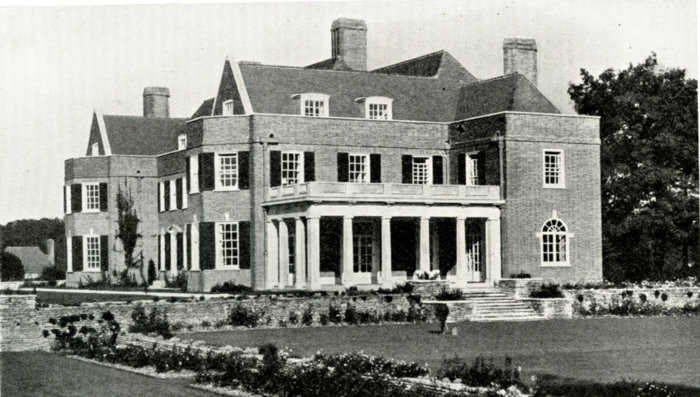In 1839, John Statham of Amersham owned a small farmhouse and a nine-acre field called Rushy Meadow, then in the occupation of Joshua Payne. In 1851, the occupant was Henry Ball, aged 77. Ball was probably a gentlemen farmer for he was listed in the gentry section of the 1854 directory as living at Russia Meadow. In 1861, James Christmas, aged 62, farmed 30 acres and employed two labourers at Rushy Meadow. He was replaced by William Hall Bolster, who was at Rushy Mead House until 1883. A much larger house was built here about 1895, by Thomas Arthur Howland, a wine and spirit merchant, who had formerly kept the George Tavern in Great Portland Street. He had several servants, gardeners and a coachman at Rushymead in 1901. About 1913, the Howland family put Rushymead on the market with an asking price of £16,000:
Rushymead, Coleshill, Amersham
An attractive freehold property of about 50 acres including modern red brick creeper-covered residence substantially built and approached by a carriage drive about 250 yards long. The accommodation comprises, on the ground floor - hall, drawing room 25' x 25', dining room 27' x 21'6, library 23' x 17' (with organ by Walker) morning room 15'9 x 13'6, billiard room 27' x 18', and usual domestic offices. On the first floor are 9 principal bedrooms, dressing room, 3 bathrooms (h & c), lavatories, etc. On the second floor are 3 bedrooms and space in roof for 3 or 4 additional rooms if required. Electric light from private installation. Main water laid on. Outside drainage on the latest principle. Gravel subsoil. Excellent stabling for 5 horses, large coachhouse, and garage, men's rooms, harness room, etc., model farmery, dairy, all in perfect order and lighted by electric light. Two large cottages with gardens. The gardens extend to about 5 acres and are inexpensive to maintain. There are 2 full sized tennis courts, croquet lawn, well-stocked kitchen gardens, orchard, etc., also there are some finely timbered park-like meadows, extending to about 45 acres, covering in all an area of about 50 acres.
The purchaser was Thomas Forbes, Chairman of Price Forbes & Co Ltd., and a Lloyds underwriter. He employed Arnold Dunbar Smith F.R.I.B.A., of Queen's Square, Bloomsbury, to rebuild the house. The new Rushymead featured in the Studio Yearbook of Decorative Art in 1924.2 Charles Pusey remembered Thomas Forbes rebuilding the house:
He built Rushymead just after the war. Previous to that it belonged to Mr. Thomas Howland who was a hotelier in London and the house apparently was a square brick place which was an eyesore so he pulled the whole thing to the ground and built Rushymead. That was just after the 1914-1918 War.
Alice, wife of Thomas Forbes, died at Coleshill in 1939, aged 76. Thomas Forbes himself died at Coleshill in 1951, aged 89. Rushymead was then bought by Broom & Wade, the High Wycombe engineering company, which used it as a staff college. In the 1960s, Rushymead was bought by Hillingdon Borough Council as an old people's home. Hillingdon was following the example of Harrow and other London boroughs in accommodating their old people in large, but relatively cheap, country houses in the Home Counties, rather than building residential homes within their own boundaries. This policy was expedient, but it meant that the individuals who went into care left the area where they felt secure and saw far less of their families. In 1991, however, ownership of the home passed to Chiltern District Council, with the object of opening a hospice there. Since then, Rushymead has housed a small hospice, whilst the remainder of the building has continued as a residential care home, run by Chiltern Hundreds Housing Association.

